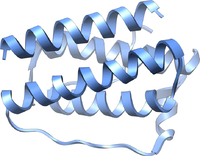
Photo from wikipedia
Leptin, a hormone that is capable of effectively reducing food intake and body weight, was initially considered for use in the treatment of obesity. However, obese subjects have since been… Click to show full abstract
Leptin, a hormone that is capable of effectively reducing food intake and body weight, was initially considered for use in the treatment of obesity. However, obese subjects have since been found to have high levels of circulating leptin and to be insensitive to the exogenous administration of leptin. The inability of leptin to exert its anorexigenic effects in obese individuals, and therefore, the lack of clinical utility of leptin in obesity, is defined as leptin resistance. This phenomenon has not yet been adequately characterized. Elucidation of the molecular mechanisms underlying leptin resistance is of vital importance for the application of leptin as an effective treatment for obesity. Leptin must cross the blood–brain barrier (BBB) to reach the hypothalamus and exert its anorexigenic functions. The mechanisms involved in leptin transportation across the blood–brain barrier continue to be unclear, thereby preventing the clinical application of leptin in the treatment of obesity. In recent years, new strategies have been developed to recover the response to leptin in obesity. We have summarized these strategies in this review.
Journal Title: Nutrients
Year Published: 2019
Link to full text (if available)
Share on Social Media: Sign Up to like & get
recommendations!